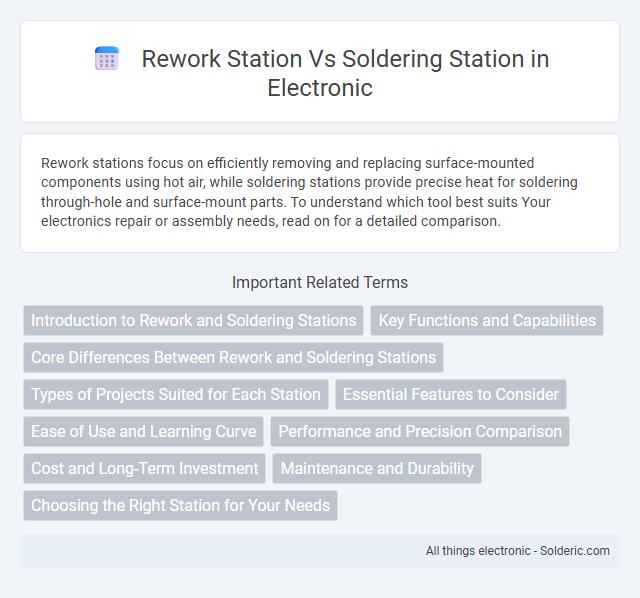Rework stations focus on efficiently removing and replacing surface-mounted components using hot air, while soldering stations provide precise heat for soldering through-hole and surface-mount parts. To understand which tool best suits Your electronics repair or assembly needs, read on for a detailed comparison.
Comparison Table
| Feature | Rework Station | Soldering Station |
|---|---|---|
| Primary Use | Component removal and replacement, especially SMD | Joining electronic components via solder |
| Heat Source | Hot air or infrared | Heated soldering iron tip |
| Temperature Control | Precise hot air temperature control (typically 100-500degC) | Adjustable iron tip temperature (typically 200-480degC) |
| Applications | Surface mount device (SMD) repairs, PCB rework | Through-hole soldering, small repairs, prototyping |
| PCB Impact | Even heat distribution, less risk of pad damage | Localized heat, risk of pad lift if overheated |
| Skill Required | Moderate to advanced | Basic to intermediate |
| Typical Cost | Higher (around $100-$500) | Lower (around $20-$150) |
Introduction to Rework and Soldering Stations
Rework stations specialize in removing and replacing surface-mounted components using hot air or infrared heat, making them essential for precise repair tasks on complex circuit boards. Soldering stations provide controlled heat through a soldering iron, ideal for assembling, repairing, or modifying electronic connections with hand-soldering techniques. Understanding the distinct functions helps you choose the right tool for either intricate rework or detailed soldering projects.
Key Functions and Capabilities
A rework station is designed for precise removal and replacement of surface-mounted components using hot air or infrared heating, making it ideal for repairing printed circuit boards (PCBs) and handling delicate parts without direct contact. In contrast, a soldering station primarily provides controlled heat through a soldering iron tip to join or repair electronic components, focusing on tasks like soldering wires or through-hole components. Your choice depends on whether you need targeted reflow capability with temperature control for surface mount technology (SMT) or versatile soldering functions for general electronic assembly and repair.
Core Differences Between Rework and Soldering Stations
Rework stations are designed for precise removal and replacement of surface-mounted components using controlled hot air or infrared heating, while soldering stations primarily provide a heated tip for melting solder to join electronic components. The core difference lies in their application methods: rework stations facilitate desoldering and reflow processes without direct contact, whereas soldering stations rely on direct contact heating for assembly and repair. Rework stations offer more advanced temperature control and airflow settings essential for delicate component handling compared to the straightforward temperature control of soldering stations.
Types of Projects Suited for Each Station
Rework stations excel in complex surface-mount device (SMD) repairs, PCB component replacement, and precision reflow tasks commonly found in electronics manufacturing and prototyping. Soldering stations are ideal for through-hole soldering, circuit assembly, and general electronics repair, supporting a wide range of applications from hobbyist projects to industrial production. Selecting between a rework station and a soldering station depends on the project's component type, precision requirements, and complexity of the soldering tasks.
Essential Features to Consider
A rework station must offer precise temperature control, high air flow adjustability, and interchangeable nozzles to handle diverse surface-mount devices efficiently. In contrast, a soldering station requires a stable temperature range with fast heat-up times, ergonomic iron design, and compatible tips for various soldering tasks. Both tools benefit from digital displays and ESD-safe components to ensure accuracy and protect sensitive electronics.
Ease of Use and Learning Curve
Rework stations offer intuitive interfaces and preset temperature profiles that simplify the learning process for beginners, making them easier to use compared to traditional soldering stations. Soldering stations require more manual control over settings and techniques, leading to a steeper learning curve for precision soldering tasks. Users seeking quick setup and automated temperature adjustments often prefer rework stations for their user-friendly design and efficient workflow.
Performance and Precision Comparison
Rework stations offer higher thermal control and rapid heating cycles essential for complex surface-mount device repairs, enhancing precision in delicate component removal and placement. Soldering stations provide consistent temperature stability suited for through-hole soldering and general electronic assembly but lack the advanced airflow and infrared heating features of rework stations. Performance in rework stations excels in minimizing thermal stress on components, while soldering stations prioritize steady heat delivery for reliable solder joints.
Cost and Long-Term Investment
Rework stations generally have a higher upfront cost compared to soldering stations due to their advanced features and versatility in handling component removal and repair tasks. Investing in a rework station can lead to long-term savings by minimizing the need for multiple tools and reducing the risk of board damage during rework processes. Soldering stations are more cost-effective for straightforward assembly work but may require additional equipment over time for addressing complex repairs, making rework stations a more strategic investment for high-volume or intricate electronics maintenance.
Maintenance and Durability
Rework stations typically require more frequent maintenance due to their complex heating elements and precise temperature controls, which are critical for tasks like PCB repairs and component reflow. Soldering stations, designed for continuous use with steady temperature delivery, generally offer greater durability and lower maintenance needs because of their simpler construction and fewer mechanical parts. Regular cleaning and timely replacement of tips in both stations extend their operational life and ensure consistent performance.
Choosing the Right Station for Your Needs
Selecting the right station depends on your specific electronic repair or assembly requirements, with a rework station excelling in removing and replacing surface-mounted components, while a soldering station offers precision for general soldering tasks and through-hole components. Your choice should consider the complexity of the job, component types, and the level of thermal control needed to ensure quality and efficiency. Investing in the appropriate station enhances your workflow, reduces damage risks, and ensures consistent results in your electronic projects.
Rework station vs soldering station Infographic

 solderic.com
solderic.com